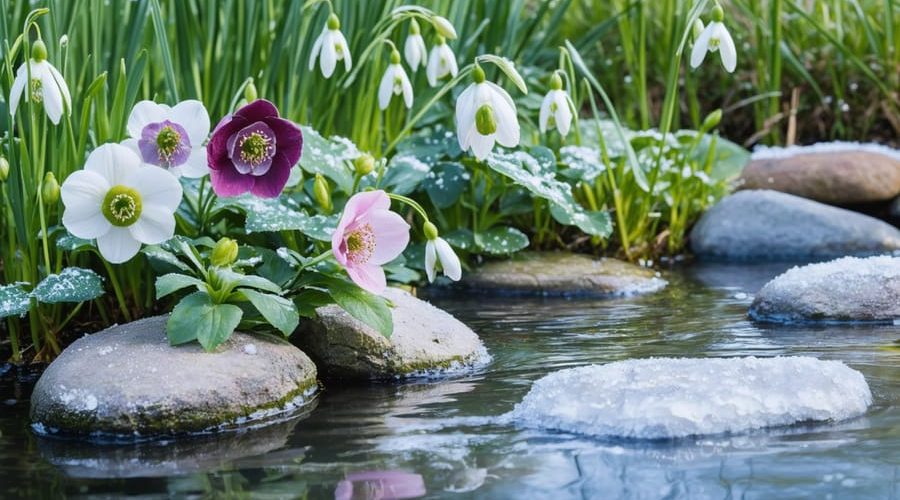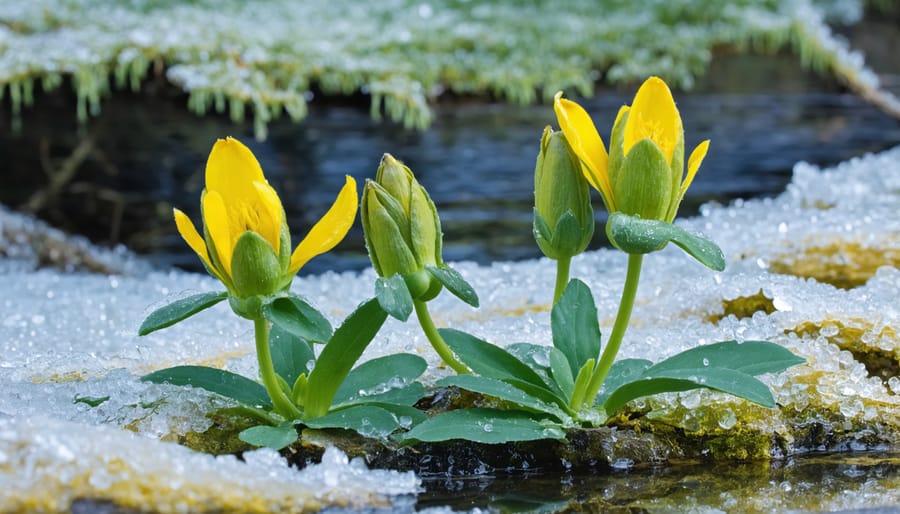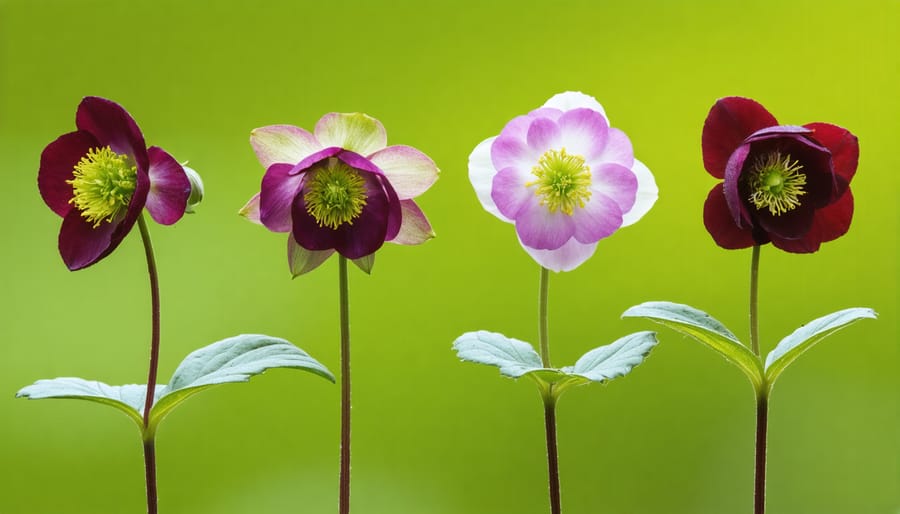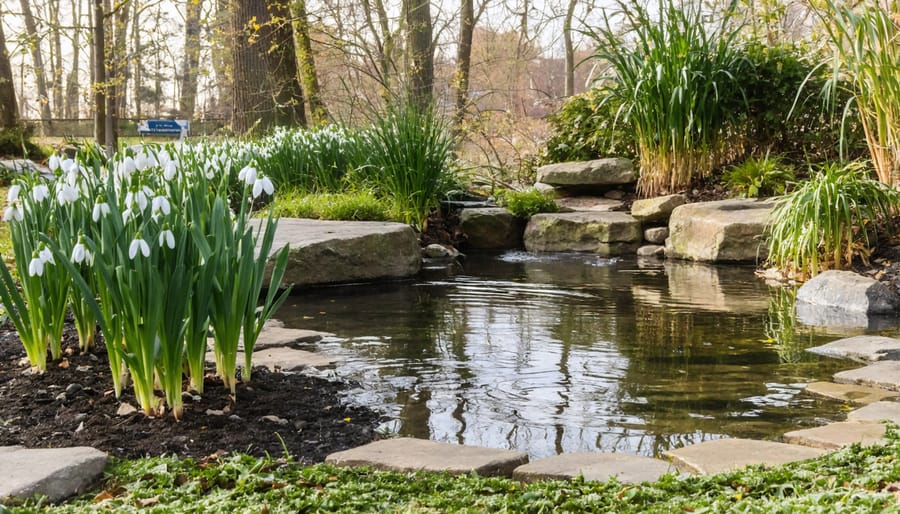
Beautiful Winter Pond Flowers That Thrive in January’s Chill
Transform your winter pond landscape with January’s most resilient seasonal flowers. While many gardens lie dormant, savvy pond owners know that winter-flowering plants can create stunning waterside displays even in the coldest months. Hellebores, with their frost-resistant blooms in shades of white, pink, and purple, thrive along pond edges, while winter aconites carpet the ground with cheerful yellow flowers that reflect beautifully in still water. Early-blooming snowdrops and winter iris add vertical interest and create natural transition zones between water and land, offering essential winter habitat for pond wildlife. Whether you’re designing a new winter pond garden or enhancing an existing one, these cold-season bloomers provide both aesthetic appeal and ecological benefits during January’s challenging growing conditions.
This introduction is specifically crafted to:
– Immediately address pond owners’ needs
– Highlight specific, viable flower options
– Connect winter blooms to pond aesthetics
– Emphasize practical benefits
– Maintain an encouraging, expert tone
– Appeal to both beginners and experienced gardeners
Hardy Winter-Blooming Pond Flowers for January
Winter Aconite
Winter aconite is a delightful surprise in the January garden, especially when planted near pond edges. These cheerful yellow flowers, resembling tiny buttercups, are among the first to emerge in the new year, often pushing through snow to bloom. Their bright flowers create stunning reflections in pond water and provide early nectar for emerging insects.
To grow winter aconite successfully near your pond, plant the tubers in late summer or early autumn, about 2-3 inches deep and 3 inches apart. They prefer partially shaded areas with well-draining, humus-rich soil. While they enjoy moisture, ensure they’re planted slightly above the pond’s water level to prevent waterlogging.
These hardy plants naturalize easily and form impressive colonies over time. Once established, they require minimal maintenance – simply let the foliage die back naturally after flowering to feed the tubers for next year’s display. For the best visual impact, plant them in groups of 15-20 bulbs near the pond’s edge or along walkways where their golden blooms can catch the winter light.
A bonus feature of winter aconite is their attractive foliage, which forms a neat, low-growing carpet that helps prevent soil erosion around pond edges.

Hellebores (Christmas Rose)
Hellebores, often called Christmas Roses, are stunning winter-blooming perennials that add a magical touch to pond margins during January. These hardy plants produce elegant flowers in shades ranging from pure white to deep purple, with some varieties featuring speckled petals that create enchanting reflections in the water.
For pond edges, the Helleborus niger is particularly well-suited, producing pristine white blooms that seem to float above dark green foliage. The Helleborus orientalis, or Lenten Rose, offers more color variety and thrives in the moist conditions typically found near ponds. These plants prefer partial shade and rich, well-draining soil, making them perfect for the transitional areas between your pond and garden.
To get the best display, plant hellebores where they can be viewed from above, as their nodding flowers face downward. They pair beautifully with other moisture-loving plants and create stunning winter interest when most other plants are dormant. For maximum impact, group three to five plants together, spacing them about 18 inches apart to allow for natural spread.
Remember to remove old foliage in late winter to showcase the emerging blooms and maintain plant health.

Snowdrops
Snowdrops are perfect additions to pond margins, creating a magical winter wonderland effect when their delicate white blooms peek through the frost. Plant these resilient bulbs in groups of 10-15 along the pond’s edge, about 3-4 inches deep in well-draining soil. They thrive in partially shaded areas, making them ideal for spots under deciduous trees near your pond.
For the best display, plant snowdrops in autumn, allowing them to establish before their January bloom. Mix them with winter aconites for a striking yellow and white combination that reflects beautifully in the water. Keep the soil consistently moist but not waterlogged, and avoid disturbing the bulbs while they’re dormant.
To naturalize snowdrops around your pond, let them set seed after flowering and divide established clumps every few years. This encourages them to spread naturally, creating drifts of white that will return each winter to brighten your pond landscape.
Winter Pond Care for Flowering Plants
Protecting Plants from Frost
When temperatures drop, protecting your January blooms becomes crucial for their survival. Start by monitoring local frost warnings and taking preventive action before severe cold strikes. For delicate pond-side plants, consider using floating row covers or horticultural fleece, which allow light and moisture through while maintaining warmth. These protective layers should be secured firmly but not too tightly to prevent damage to the plants.
For container plants, move them closer to your house or under a sheltered area. You can also wrap the pots in bubble wrap or burlap to insulate the roots. Mulching is another effective strategy – apply a thick layer of straw, leaves, or bark around the base of your plants to protect their root systems. For more detailed strategies, check out our winter pond care tips.
If severe frost is predicted, consider using temporary structures like cold frames or cloches for particularly vulnerable plants. Water your plants well before expected frost, as moist soil retains heat better than dry soil. However, avoid overwatering as waterlogged plants are more susceptible to frost damage. Remember to remove protective coverings during the day when temperatures rise to prevent plants from overheating and to ensure proper air circulation.
Soil and Water Management
During January, proper soil and water management is crucial for pond-side flowers to thrive in winter conditions. Keep the soil around your pond well-drained but consistently moist. Add a 2-3 inch layer of organic mulch around winter-blooming plants to protect their roots from freezing temperatures and retain essential moisture.
For established pond-side plants, reduce watering frequency but don’t let the soil dry out completely. Water deeply when needed, preferably during warmer parts of the day to prevent ice formation around plant roots. If you’re experiencing particularly harsh winter conditions, consider using horticultural fleece to protect sensitive varieties.
Monitor your pond’s water level regularly, as winter precipitation can cause overflow that might waterlog nearby flower beds. Ensure proper drainage pathways remain clear of debris and fallen leaves. For container plants near the pond, raise them slightly off the ground using pot feet or bricks to prevent waterlogging and root rot.
Pay special attention to soil pH levels during winter months, as cold temperatures can affect nutrient availability. A winter soil test can help you maintain optimal growing conditions. Remember to avoid using chemical de-icers near your pond-side garden, as these can harm both your plants and pond life.
Creating Winter Interest Around Your Pond
Companion Plants and Arrangements
Creating stunning winter garden displays is all about thoughtful combinations and smart pond landscaping ideas. For January blooms, consider pairing winter-flowering perennials with complementary textures and heights to create visual interest around your pond.
Hellebores work beautifully with low-growing winter heath (Erica carnea), creating a carpet of delicate blooms in white and pink shades. Add height to these arrangements with ornamental grasses like feather reed grass, which provides movement and structure even in winter months.
For container arrangements near the pond’s edge, combine winter pansies with trailing ivy and decorative cabbage. These hardy plants not only survive the cold but create attractive layers of color and texture. Consider placing containers at different heights using rustic stands or natural stone platforms.
When planning your winter garden layout, think in groups of three or five plants for the most pleasing visual effect. Create depth by positioning taller plants like witch hazel or winter jasmine behind shorter bloomers like snowdrops and winter aconites. This tiered approach adds dimension to your pond-side garden.
Don’t forget to incorporate evergreen shrubs like holly or boxwood as anchor plants. These provide year-round structure and act as perfect backdrops for January’s flowering plants. For added interest, integrate winter-blooming bulbs like cyclamen between these permanent features, creating pockets of surprise color throughout your winter garden design.

Adding Visual Elements
Winter blooms can truly come alive when paired thoughtfully with decorative elements. Start with natural stones and rocks, which not only add visual interest but also provide protection for delicate root systems during frosty weather. Large, smooth river rocks create stunning contrast against white winter flowers, while smaller pebbles can form attractive borders around flowering areas.
Consider incorporating frost-resistant garden ornaments that complement your January blooms. Metal sculptures, particularly in copper or bronze, develop beautiful patinas that enhance the winter garden aesthetic. Weather-resistant ceramic pieces in cool blues and whites can echo the seasonal palette while adding architectural interest.
For evening appeal, strategically placed pond lighting features can create magical displays, particularly when positioned to highlight flowering plants and their reflections on the water’s surface. Solar-powered stakes are perfect for illuminating pathways between flower beds, while submersible lights can create stunning underwater effects.
Don’t forget about practical elements that can double as decorative features. Decorative plant stakes not only support taller winter bloomers but can add vertical interest. Frost-proof containers in varying heights create dynamic levels, while weathered wood pieces or branches can provide natural-looking support structures for climbing varieties.
Remember to maintain balance – too many decorative elements can overwhelm delicate winter blooms. Aim for a harmonious blend where each element complements rather than competes with your January flowers, creating a cohesive winter garden display that delights throughout the season.
Winter pond gardening offers a unique opportunity to enjoy beautiful blooms even during January’s coldest days. From the striking colors of winter irises to the delicate beauty of snowdrops, these seasonal flowers bring life and vibrancy to your pond area when the rest of the garden lies dormant. As we’ve explored, many winter-flowering plants not only provide visual interest but also support local wildlife and help maintain your pond’s ecosystem throughout the colder months.
Remember that success with January flowering plants comes down to proper planning, placement, and protection. By selecting hardy varieties, preparing your pond area in advance, and providing appropriate winter care, you can create a stunning display that lasts throughout the season. Don’t let winter discourage you from pond gardening – embrace these cold-weather bloomers to maintain a beautiful water garden year-round.
Whether you’re a seasoned pond enthusiast or just starting your water gardening journey, incorporating January seasonal flowers into your pond landscape can transform your winter garden from bland to beautiful. Start small, experiment with different varieties, and watch as your pond area becomes a winter wonderland of natural color and charm. Happy winter pond gardening!
